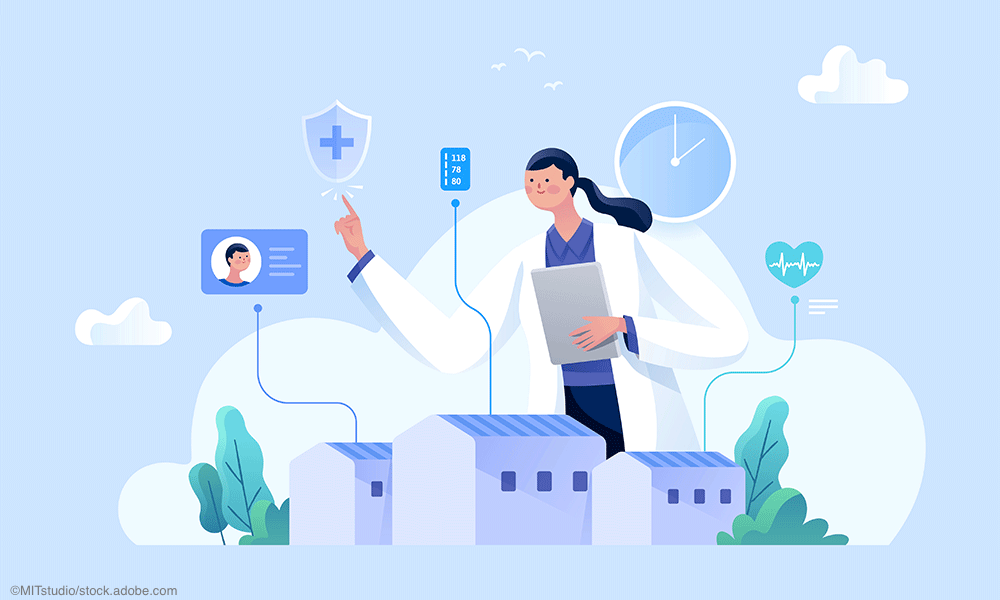Drive patient retention with Remote Patient Monitoring
Five tips for a successful RPM program.

Value-based care payment models and reimbursement changes from the Centers for Medicare and Medicaid Services (CMS) prompted adoption of remote patient monitoring (RPM) programs in practices nationwide. COVID-19, however, sent that adoption into overdrive with as many as 30 million patients expected to use some type of RPM tool by 2024. Although the COVID-19 pandemic may be waning in the U.S., RPM adoption will continue.
RPM’s continued growth can be attributed to many reasons. Most significantly, RPM helps improve patient adherence and outcomes, which reduces overall healthcare spending. RPM itself can be less costly if it helps practices work more efficiently, but that fact is highly dependent on the technology used to support an RPM program. By increasing adherence, an RPM program can ultimately drive the patient engagement that leads to long-term patient retention—which can improve a practice’s bottom line.
Creating an RPM program that drives such engagement can be challenging. Here are five important tips for success:
1. Two E's of Setup: Education and Expectations
Patients need to be educated on the “why” and “how” of RPM. For example, if they receive a blood pressure cuff to use at home, they should be instructed on proper operation as well as their responsibilities for reporting any other vitals and subjective data they need to share, such as fatigue, nausea, or dizziness. RPM technology platforms can reinforce education provided in the practice with directions they can review at home and automatically remind patients to capture their vitals, off-loading that burden from clinicians.
2. Ease of Use
If an RPM program is not easy to follow, patient adherence will diminish, creating more work for staff and disengaging patients. Practices need to consider patients’ tech-savviness and learn if they have Wi-Fi or broadband access at home or choose a program that uses cellular data reporting to avoid issues caused by access. Creating a simple RPM program and choosing an easy-to-use platform that accommodates patients’ technological abilities will drive consistency that leads to habit and ultimately retention.
3. Simple user-friendly interfaces (for both providers and patients)
An easy-to-use platform should be easy for both patients and providers. Interfaces should be simple to navigate, and entering data and accessing information should be simple or automated when possible. Many practices manage thousands of patients per month, so providers need to quickly assess how their patients are adhering to their care plan and identify those who need an intervention based on their vitals and other patient-reported data. These targeted, relevant interventions will make patients feel valued, which in turn will drive engagement and retention.
Specifically for practices, the RPM technology should automatically track time spent on care to ensure appropriate reimbursement for new chronic condition management and remote physiologic (as noted by CMS) monitoring CPT codes.
4. Behavior-based reminders
Automated reminders sent to a patient’s smartphone or email based on their reported data, healthcare utilization (such as an emergency department visit), or lack of adherence can help boost or restore engagement. Reminders can be more relevant and actionable for patients when they are based on specific actions or health events that are identified in the RPM platform, such as an unscheduled telehealth visit or unusual weight gain. When sent directly from the provider following such incidents, reminders and inquiries instill a sense of accountability in the patient, which drives engagement.
5. Passive identification of eligible patients
It can be challenging for high-volume practices to find the time to identify patients who would be ideal to enroll in an RPM program beyond the initial rollout. RPM technology is available that uses data analytics to study a practice’s patient population and flag potential candidates based on pre-selected criteria, such as chronic conditions, age, sex, health plan, or any combination thereof. The technology can also automate some of the outreach, enrollment, and communication steps and coordinate telehealth appointments to minimize burden on clinicians.
RPM is Here to Stay
Adoption and capabilities of consumer-grade health monitoring devices is rapidly advancing. For example, the newest version of the Apple Watch can now detect blood oxygen levels and sleeping respiratory rates while new consumer weight scales can measure a person’s vascular age and deliver a full-body composition analysis, including bone mass.
Patient engagement with these devices is driving demand for and familiarity with data-driven monitoring of their health, which can work synergistically with an RPM program at your practice. Technology selection is crucial; your program must be able to efficiently manage incoming data and turn it into meaningful information and insight. With an intuitive interface and automated administrative tasks, reminders, and communication, the technology can enable care managers to focus on the highest-need patients to prevent unnecessary care utilization, reducing costs and improving outcomes.
The resulting engagement as well as positive outcomes and financial returns will turn RPM into an indispensable part of your practice.